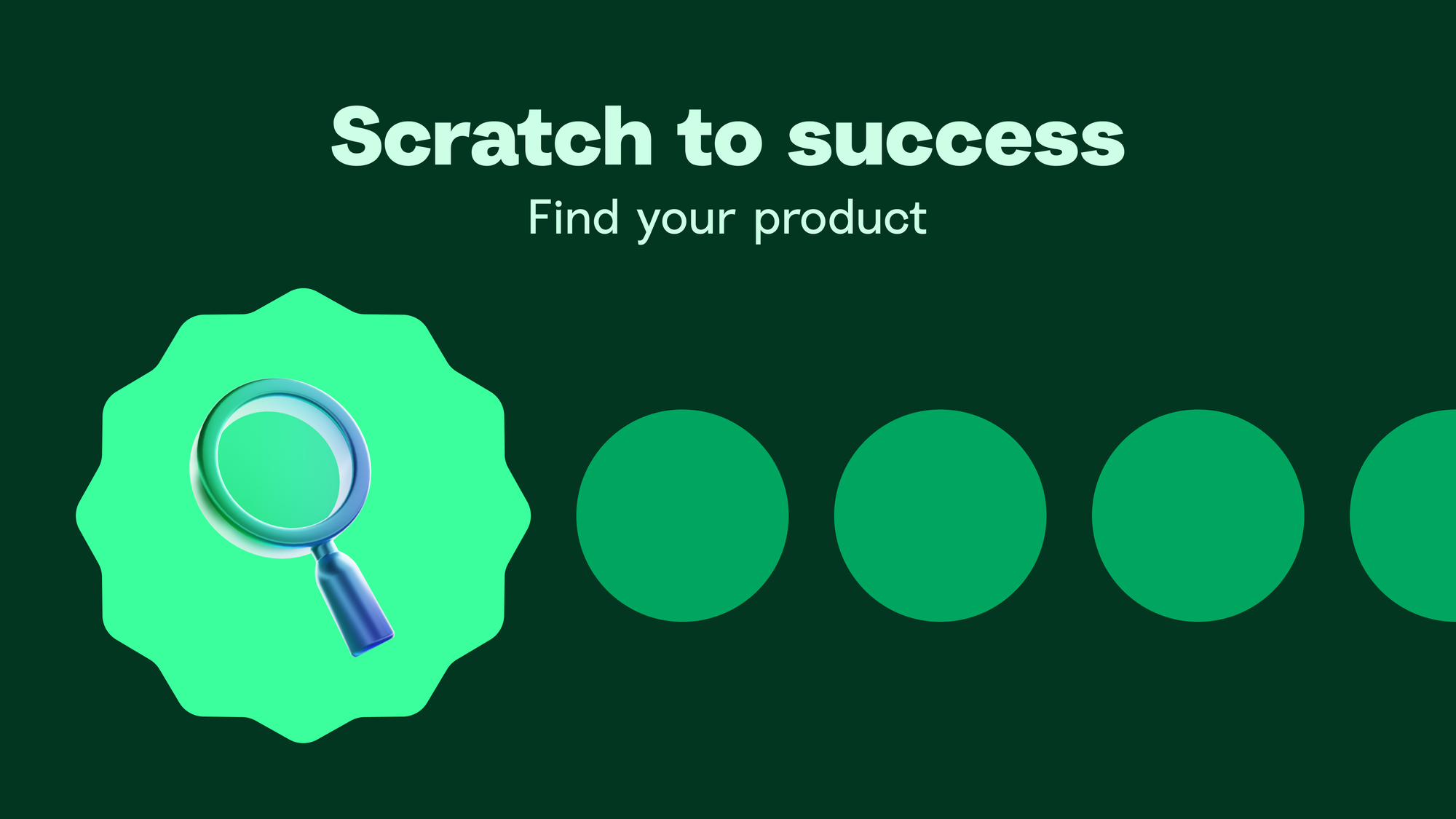Finding your product | Scratch to success

In this series of Muqasama guides, we take you through starting and growing your own ecommerce business. Instead of giving clickbait advice, we'll detail practical steps and relay the advice of real ecommerce entrepreneurs to ensure you get the best and most actionable tips.
How to get started
To set your ecommerce journey off on the right foot, you need to be able to answer three questions:
- What will you sell?
- How do you know it will sell?
- Where will you source your products?
What will you sell?
Any new business needs to add value to its consumers. In the retail industry, that means making shoppers' lives better. For a successful retail business, adding value doesn't necessarily mean Apple's level of innovation. It could also mean providing more choice, affordability, quicker delivery times, or simply being the first option your customer sees.
Product market fit
Before you start your ecommerce journey, you need to assess yourself, what you want to achieve and where your product will fit into the market.

The graph positions brands according to their size and the complexity of the supply chain. The top right quadrant is full of large dominant players who realistically will not be challenged by entrepreneurs due to the protection of a high entry barrier. You will have difficulty creating a new electric car or smartphone to challenge in the top right square.
High production is also challenging to smaller players as it will take a lot of time to turn your initial investment into profit. The exception to this rule is artisan crafts such as jewellery or handmade items. If you have years of craftmanship or a clever sales strategy, your brand can carve out some of the market.
Hiral, the co-founder of Carat Craft, solved this problem by determining that established jewellers had yet to invest in an excellent online shopping experience. So, Hiral built legitimacy for Carat Craft by creating a professional online shop that trumped the existing established players.
Your personal attributes
You will recognise most of the region's latest retail success stories in the bottom two quadrants. Peacefull, Squatwolf, and The Giving Movement are all brands that have entered low barrier-to-entry but fiercely competitive markets. They have all come up with points of difference to carve out their own sections of the market and become hugely successful retail brands.
There is also the question of your personal journey and skillset. While it's not unheard of for entrepreneurs to succeed in industries with no experience to get the upper hand, the founder's story is often a crucial part of the brand's success.
Salama Mohamed's journey to starting Peacefull started with trying to find a skincare solution for her sensitive skin and vitiligo. Peacefull was born from that, as she wanted to share what she had found with her community.
Wajdan Gul and his wife, Anam Khalid, were already fitness fanatics when they launched Squatwolf, and their relationships with local gyms gave them a step up into the activewear market.
Your character, skills, and previous experience can often dictate the direction of your business, so it must be taken into account when drawing up plans to build your brand.

This guide demonstrates the ease of market entry and the questions you need to ask yourself before committing to an idea. If your answers are down the left-hand side, then your initial costs and time to success will be less. If your answers are down the right it will require much more investment and time to build a successful retail brand.
This is your chance to do your competitor research. Look at all your potential competitors and identify their strengths, weaknesses, opportunities, and threats. Build up a picture of the industry you are trying to enter. You can refer to this information when you plan your retail strategy and business plan.
How to know if it will sell
Finding your product's market fit and understanding whether it will sell go hand in hand. In such a competitive space, it is crucial to gather actual data to determine whether you have a viable business idea or just a pipe dream.
You should take a few simple steps to gather valuable data and gauge the future success of your product.
Run ads
Create some simple social media ads and run them on a small budget.
You can hack together a simple storefront on a platform such as Shopify, Zid or Salla to measure clicks, or run a simple landing page that captures email addresses. Either will give you a good understanding of your product's interest level.
At this stage it's just about gauging a level of interest in your product, rather than making a profit. Once you are stocked and launched properly you can re-target those that engaged with your ads to recoup some of your ad spend.

The advantage of getting this data is that it is unbiased, and you can gather a lot of data quickly and relatively cheaply. You can also adjust the audience to see your product's performance with different demographics. You can also run creatives with various prices to gather data for your pricing strategy.
Surveying
A more old-school approach to gathering data is through face-to-face interviews. Since face-to-face feedback is likely to have a positive bias, this can be an excellent step to take after you have established popularity by running a few ads. Interviews will help you fine-tune what customers like (or dislike) about your product, allowing you to adjust your strategy before launch.
There are also ways to gather data without going out and about yourself. You can run polls on social media or use existing databases to send out a survey through email. Some third-party companies can help you send your survey to the specific demographic of your target market.
Sourcing your products
After establishing what you will sell and if it will sell, it's essential to research how you will source your product. Your decision here will impact your retail strategy moving forward.
You can create the products yourself after sourcing the raw materials or use a manufacturing partner. It's also often good practice to build your business up through each level of production to limit the risk. Once you build up enough capital through selling your handmade items, you can look for a white-label supplier. Similarly, once you sell enough white-label goods, you can look into creating your own bespoke manufacturing process.
Create it yourself
This option is only viable for low-level craft-based brands with low sales or projects with large amounts of capital available. Most brands that end up creating their own manufacturing processes would have started by outsourcing their manufacturing until they reached a tipping point where they were making enough sales to invest in their own processes.
Manufacturer
The most common source for retail start-ups is buying directly from the manufacturer. This route offers two options: You can buy white-label products to customise or create a bespoke private product line with them.
White labelling is putting your branding on an existing 'off the shelf' product. This can be a rapid and cost-effective way to start building your inventory. But you run the risk of selling nearly identical products to your potential competitors.
Creating a bespoke product line is an excellent option for sourcing a scalable solution that you want. It's a more expensive and time-consuming option, but it ensures that you get the product exactly as you envisioned.
It's also worth remembering that most bespoke product lines require a minimum order quantity.
Picking a manufacturer

In the Middle East, most of the retail manufacturing is done in China or India.
You can use a supplier marketplace to look through their products to find the right supplier.
When browsing your options, use the following checklist to compare each supplier.
- Check if the supplier can create your specific product, including the necessary skills, resources, and automation capabilities.
- Understand the time required to produce and ship items to avoid long customer waits.
- Determine the shipping expenses, as they can significantly impact your overall costs.
- Know the minimum order requirements (MOQ), often negotiable, before production starts.
- Negotiate the cost per unit alongside MOQs; larger orders typically reduce the unit cost.
- Ensure any tools you buy for production are used exclusively for your products, and consider asking for market or territorial exclusivity.
- Inquire about any fees charged to prepare equipment for manufacturing your goods.
- Clarify who is responsible for the costs of defective items and their shipping.
- Investigate the factory conditions and their environmental and social impact.
- Understand their standard payment terms. Negative cashflow is the holy grail of ecommerce, look for long payment terms but bear in mind as a start up you hold less negotiation power.
Design
After you find a supplier and negotiate MOQs and payment terms, they will give you the design specifications they need to fulfil the order. If you don't already have your designs ready, you will need to work with a designer. If you need a freelancer, look at Ureed or Khamsat to get started.
Samples
Getting and approving samples before you roll out production is vital. There might be a cost to get samples made, but it is worth it to mitigate the risk of receiving substandard products.
Make sure to date and sign a couple of control samples to compare the quality of each new batch produced.
Order
As with this whole process, it's an exercise of mitigating as much risk as possible. You can always order more if you under-order, but it can be financially disastrous if you over-order. This is where it's advantageous to go with a supplier with a low MOQ or generous payment terms.
What's next
Before you send over your final confirmation for your first order, make sure you have a solid business plan and a watertight financial model in place. In our next guide, we will outline how you can create your own retail strategy and business plan.

